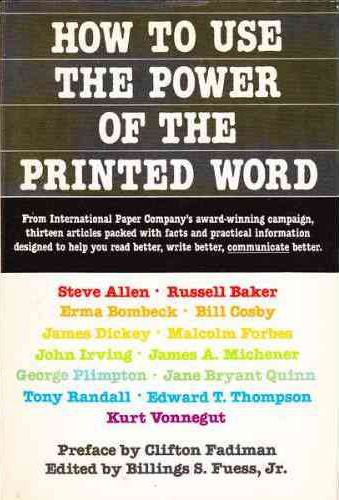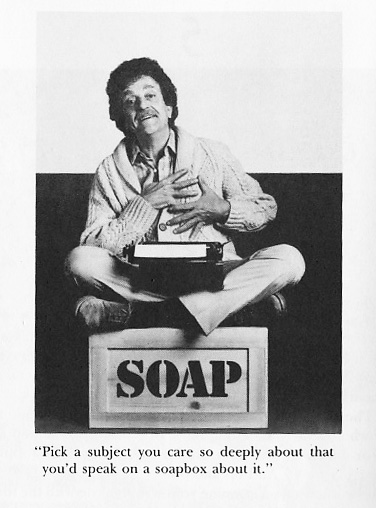
Lykos with ‘Taverna Akrogiali’ in the middle!!! This place is my second home and is located in the south west of Crete in Greece!!!



How to Write with Style: Kurt Vonnegut’s 8 Keys to the Power of the Written Word | Brain Pickings.
by Maria Popova
“The most damning revelation you can make about yourself is that you do not know what is interesting and what is not.”

Kurt Vonnegut has given us some of the most timeless advice on the art and craft of writing — from his 8 rules for a great story to his insights on the shapes of stories to his formidable daily routine. But hardly anything examines the subject with a more potent blend of practical advice and heart than Vonnegut’s 1985 essay “How to Write with Style,” published in the wonderful anthology How to Use the Power of the Printed Word (UK; public library).
Vonnegut begins with an admonition against the impersonal sterility of journalistic reporting — something particularly important amidst contemporary debates about how personal the writerly persona should be — and a meditation on the single most important element of style:
Newspaper reporters and technical writers are trained to reveal almost nothing about themselves in their writing. This makes them freaks in the world of writers, since almost all of the other ink-stained wretches in that world reveal a lot about themselves to readers. We call these revelations, accidental and intentional, elements of style.
These revelations tell us as readers what sort of person it is with whom we are spending time. Does the writer sound ignorant or informed, stupid or bright, crooked or honest, humorless or playful–? And on and on.
Why should you examine your writing style with the idea of improving it? Do so as a mark of respect for your readers, whatever you’re writing. If you scribble your thoughts any which way, your reader will surely feel that you care nothing about them. They will mark you down as an ego maniac or a chowderhead — or, worse, they will stop reading you.
The most damning revelation you can make about yourself is that you do not know what is interesting and what is not. Don’t you yourself like or dislike writers mainly for what they choose to show or make you think about? Did you ever admire an empty-headed writer for his or her mastery of the language? No.
So your own winning style must begin with ideas in your head.

Juli Zehs Poetikvorlesung: Vom Nur-So zum Roman – Autoren – FAZ.
08.07.2013 · Juli Zeh verteidigt in ihrer Frankfurter Poetikvorlesung Literatur als einen Rückzugsraum der Anarchie, eingefangen zwischen zwei Buchdeckeln. Und beschreibt damit zugleich ihre eigenes Verfahren.
Am Ende der dritten Vorlesung war Juli Zeh bei ihren Kritikern angelangt. Versammele sie alle Stimmen, die seit je versicherten, die Autorin Zeh tauge nichts, dann klinge das in etwa so: „Zuerst das Gute: Der neue Roman von Juli Zeh ist weniger lang als seine Vorgänger.“ Die Konstruktion der Rahmenerzählung aber sei ebenso bemüht wie die Sprachfähigkeit der Autorin begrenzt. Juli Zeh sei eine „Schwallmadame“, „Quatschnudel“, „Dauerpowerfrau“, und „apokalyptisch altkluge Angeberin“. Glücklicherweise wolle sie sich nun ihrer juristischen Doktorarbeit zuwenden. „Da kann sie weiter Thesenklappriges aufeinanderstapeln. Und das Beste: Lesen muss es nur einer.“
Das, sagte Juli Zeh anschließend, stamme nicht von ihr, sondern sei eine kleine Zitatencollage aus Rezensionen ihrer Bücher der letzten Jahre. Ihre Frankfurter Poetikvorlesung kam damit der Literaturdefinition der Romantiker relativ nah: dass ein Werk nämlich immer auch seine Kritik enthalten solle. Das galt auch jenseits ironischer Anklänge. Denn Zehs Poetikvorlesung, einige Tage vor Beginn bereits unter dem Titel „Treideln“ im Schöffling Verlag erschienen, war mit nahezu jedem Satz eine Wiederbelebung romantischen Literaturverständnisses. Wenn sie schreibe, hatte Zeh in der zweiten Vorlesung erklärt, dann in Form des „Nur-So“: „Das Nur-So ist eine Textart, die jederzeit gelöscht werden kann. Sie dient keinem Leser, sondern ausschließlich dem Autor. Das Nur-So besteht aus Textfetzen, Szenen, Kurzdialogen, einzelnen Sätzen oder auch kleinen, in sich geschlossenen Episoden. Ein Nur-So kann zu beträchtlicher Länge anwachsen.“ Etwa so seien fast alle ihre Romane entstanden. (…)
Das getäuschte Gehirn – Sehen, Erkennen, Zauberei.
Wir nehmen die Umwelt vor allem durch die Augen wahr. Aber ist das, was wir sehen, auch tatsächlich Realität oder ist es nur eine Vorstellung? Neurowissenschaftler haben nachgewiesen, wie sehr unser Bild von der Umwelt durch das Gehirn konstruiert wird. Das ist Ursache vieler Täuschungen und Illusionen. Bedeutet das jedoch, dass die gesamte Sicht der Welt reine Konstruktion ist und es die eine Realität nicht gibt? Diesen und anderen Fragen wird Gert Scobel im Rahmen des NeuroForums der Hertie-Stiftung nachgehen.(…)
Consciousness: why bother? | Chris Frith | Science | guardian.co.uk.
Friday 2 March 2012 12.27 GMT
The collection of abilities and experiences that we call the mind emerges from the brain, so the study of the brain can provide important information about the mind. For most of the 20th century, mind-brain relationships could only be explored in people with damaged brains, typically caused by strokes or head injuries. Such damage can result in loss of consciousness, and in extreme cases coma, but more interestingly it can also result in changes in the content of consciousness.
There can be loss of some aspects of sensory experience despite the sense organs remaining intact, and there can be novel and unusual sensory experiences such as hallucinations. For example, damage to the colour area in the visual part of the brain can result in loss of colour experience, even though the colour receptors in the eye are working normally. Furthermore, abnormal activity in this area can lead to hallucinations of colour.
Studies of patients with brain damage reveal how much can be achieved without awareness. Patients with damage to the right side of the brain („spatial neglect„) can successfully pick out the better of two objects (eg. an intact rather than a damaged house) while reporting that they cannot see any difference between them. Patients with damage to visual areas of the brain („visual agnosia“) can’t recognise objects from their shape, but will adjust their hand to the shape of the object when picking it up. In these cases, information of which the patient is unaware is nevertheless sufficient to achieve a successful action. (…)
Frith C.D. (2007) Making up the mind, Wiley-Blackwell.